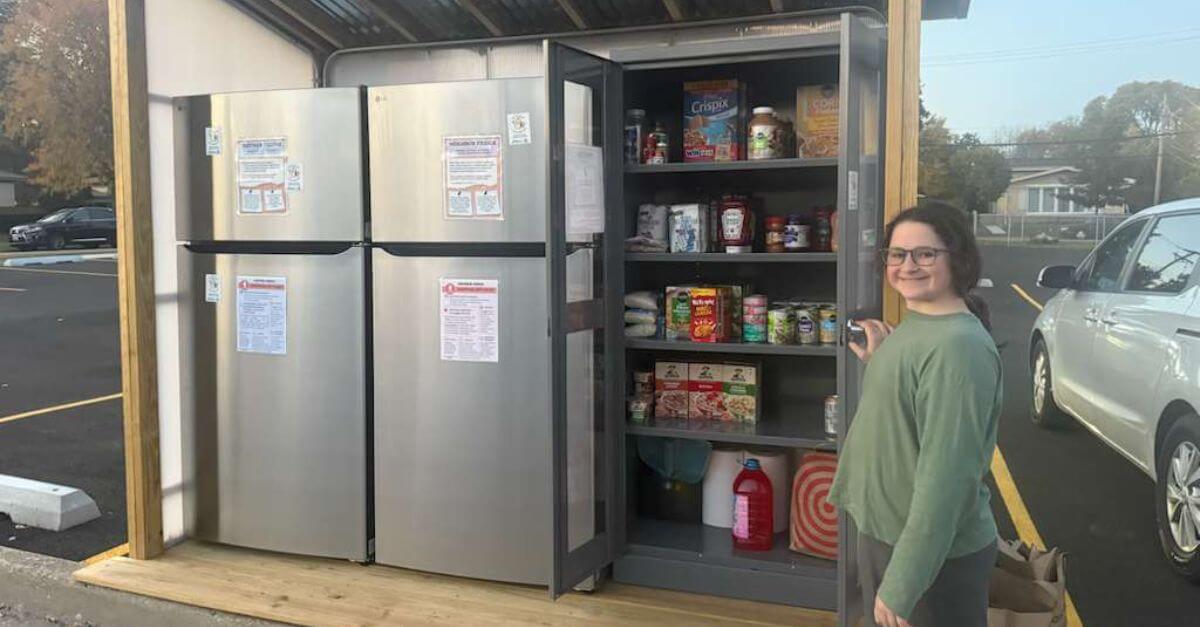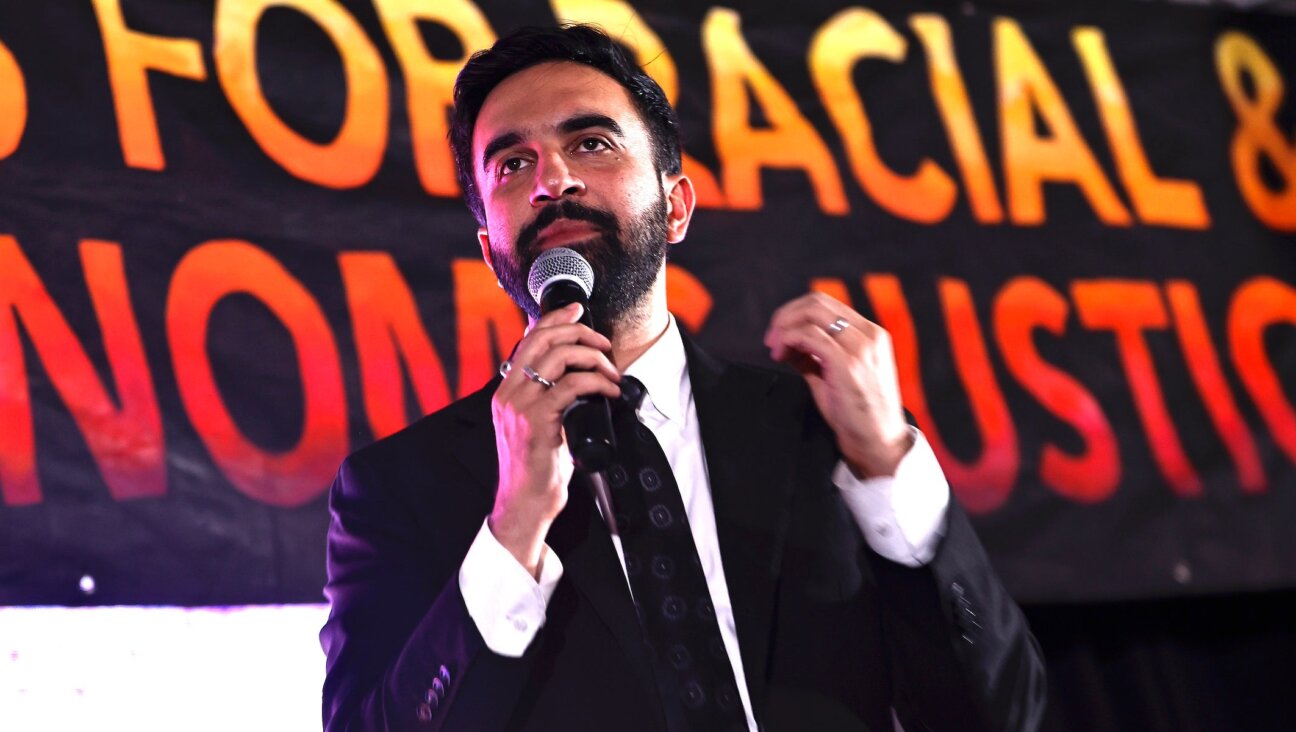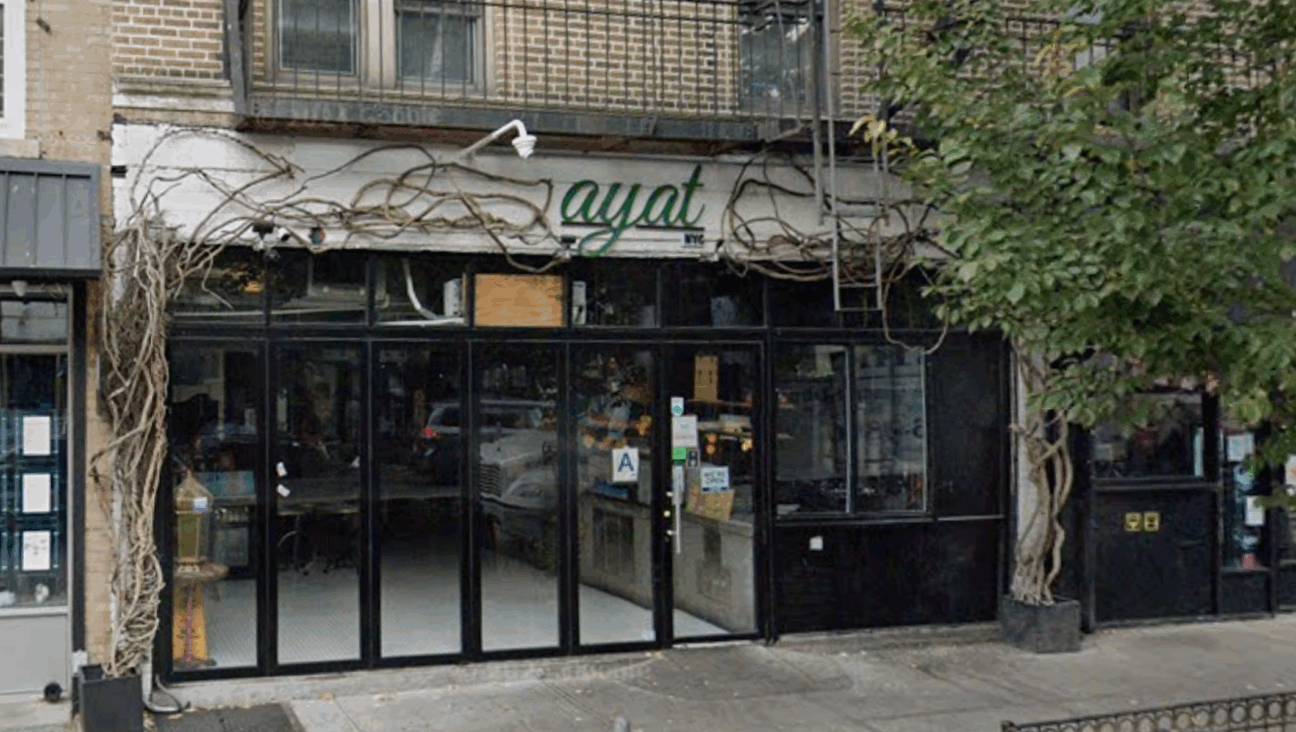Last Ethiopian Jews Finally Make Exodus to Israel

Graphic by Angelie Zaslavsky
In the half-light of dawn, 16 families huddle on benches in the early morning chill, waiting patiently for their journey to a new and unimaginable life. They sit in a courtyard, hidden from the view of friends and relatives who have come to say farewell, behind the modest local offices of the Jewish Agency for Israel, in a walled and guarded lot.
The women, wearing headscarves, are wrapped in flowing gabis — traditional Ethiopian throw blankets. Some men are dressed in Western clothing; others dress more traditionally and grasp their dulas, or walking sticks. Some of these 82 adults and children have crosses tattooed on their foreheads, emblematic of their Christian backgrounds — and of the status that has kept them and their compatriots waiting in Gondar for a decade or more to emigrate to Israel despite their validated claims of Jewish ancestry.
But the previous morning, the heads of these families were handed a small travel allowance by officials from the Jewish Agency for their long awaited journey. Each signed the acknowledgement of receipt with a thumbprint. As village people who used to farm with oxen and are now day laborers, it is clear that they will not fit into Israeli society easily.
View a slideshow of images of the Falash Mura:
Twenty years after the second of two mass airlifts of Ethiopian Jews to Israel, the seemingly endless trickle of other Ethiopian immigrants who claim Jewish ancestry is coming to a long-delayed conclusion. Known as Falash Mura, such Ethiopians lived as Christians for generations in order to escape persecution. But in recent decades, they asserted their Jewish ancestry and began to practice Judaism. Their relatives in Israel have petitioned the government to allow them to immigrate and join the estimated 130,000 Ethiopian Israelis already there, including roughly 35,000 other Falash Mura.
These 16 families in Gondar are among the early beneficiaries of Cabinet Decision No. 2434 of November 14, 2010, which committed Israel to ending the immigration of Ethiopians with the intake of some 8,700 more Falash Mura within two to three years.
Although there have been several claims in past years that the immigration from Ethiopia was finished, the major players all seem to agree that this time it feels genuine. “This is absolutely the end of the organized aliyah from Ethiopia,” says Shlomo Molla, the only Ethiopian member of Israel’s Knesset. “After the families approved in Gondar come in, immigration from Ethiopia will be on an individual basis like anywhere else.”
The Falash Mura are being brought in not under Israel’s Law of Return, which grants Jews an automatic right to enter and become citizens, but under the Law of Entry, for family reunifications. This enables the Ministry of the Interior to set its own guidelines. Those slated to enter via this final wave have consequently faced criteria and scrutiny that give new meaning to the phrase “the chosen people.”
Under the terms of the November 2010 Israeli Cabinet agreement, entry will be limited to Ethiopians who appear on an existing census of Falash Mura, those who can prove matrilineal Jewish ancestry going back two generations, and those whose relatives in Israel have petitioned the government to allow them to immigrate. Nearly all of the Falash Mura gathered in Gondar have been waiting there for more than a decade. But it is expected that some 10% to 20% will not meet the matrilineal criterion — the traditional religious qualification for being considered a Jew.
At the entry rate of 200 immigrants per month specified by the November 2010 decision, the wait for some families could be another three years. But in June – typical of what has been happening to the Falash Mura aliyah – the Finance Ministry, citing the budget for immigrant housing, recommended that the rate be cut from 200 to 110 immigrants per month. For some, this will prolong the wait to 2015.
Israelis became aware of the Falash Mura when thousands appeared in Addis Ababa, just before Operation Solomon, the 1991 airlift of more than 14,000 Beta Israel (Ethiopian Jews whose ancestors never abandoned their Jewish practice). Then-Prime Minister Yitzhak Shamir declined to take them in, believing they were Christians who were claiming Jewish identity to escape Ethiopia, which was in the midst of a civil war. Although many influential Israelis, including Chief Sephardic Rabbi Shlomo Amar and a former Supreme Court justice, have since concluded that the Falash Mura are “Jewish beyond a doubt,” many still adhere to Shamir’s point of view or versions of it.
Another shadow has been cast over the Ethiopians’ immigration by the difficulties Israel has had in absorbing and integrating the Ethiopian community generally and the high cost of the social services they require. Since 1992, the aliyah of the Falash Mura has stumbled through a morass of policy reversals and budgetary obstacles. In fact, the Falash Mura aliyah was declared “over” in 1998 and again in 2008, until protests and court cases restarted it. It gathered momentum once again, thanks to the November 2010 cabinet decision, which appeared to declare the Ethiopian families and their advocates winners in the long-standing tug-of-war.
At the northern Ethiopian village, two buses have pulled up in front of the gate, and the families will soon board them for a 12-hour ride to Addis Ababa and then a four-hour flight to Israel. Above the assembly area where they sit expectantly, a large, printed sign in English and Amharic reads “Waiting Area” – a darkly comic understatement. Most of these Falash Mura families have languished in undeniable poverty for 10 years or more after leaving their villages and abandoning all they owned to come to Gondar with the hope of immigrating to Israel. Near the entrance to Gondar’s large Jewish cemetery, accessible only by foot a few miles away through the rolling hillsides is a recent grave with a marker that says, “Died waiting to go to Israel.” The same epitaph applies to hundreds.
At a signal from JAFI’s representative in Gondar, Asher Seyum, who escaped from Ethiopia to Israel in 1984, the quiet crowd files out of the courtyard, through the gate and onto the road. Hired workers climb ladders and strap luggage to the roof racks. Perhaps 40 yards down the road, friends and family look on tearfully, bravely smiling, frightened, perplexed, many of them waving repeatedly to loved ones who are boarding the buses. The prospective new immigrants, old and young alike, look back and wave at their loved ones, with only a guess at when, or if, they will see them again. Soon, the buses drive off and the spectators drift away, down one of the many dirt roads toward the surrounding homes.
Seyum, dressed in an elegant ensemble that would not be out of place in a corporate boardroom, observes the departure-in-progress approvingly. His role is to prepare those approved by the Interior Ministry staff for transit to Israel. This includes vaccinations, chest-X rays to screen for tuberculosis, and lectures to ready them, minimally, for the culture shock to come. “They are told only two days before the trip,” Seyum explains, “so they cannot plan for any ‘extra children’ to board.” From January 1 to the end of July, exactly 2,339 new Ethiopian olim out of the 8,700 qualified made this same trip, by JAFI’s count. So far, the plan is running ahead of schedule, but the predicted absorption center housing shortage threatens to change that.
Watch a video of the Falash Mura preparing to leave:
The Falash Mura live in rudimentary huts near the Jewish compound of Gondar, a set of buildings funded and operated by the New York-based North American Conference on Ethiopian Jewry (NACOEJ) where they have been offered services since 1999. The compound buildings house an outdoor, dirt-floor synagogue. Each morning, hundreds of men, donning tallitot and tefillin, take their place along benches to pray. Women dressed in white sit on the other side of the mechitza, or curtain, that divides men and women during traditional prayer. Shabbat services attract close to 1,000 people. Under the same metal roof are a mikveh, or ritual bath, and a feeding station for nursing mothers and young children. A few miles away, NACOEJ has built and staffed a school for hundreds of Falash Mura children who learn Hebrew and study secular subjects there.
The Israeli Cabinet hammered out its November 2010 decision after behind-the-scenes deal making exacted promises from high-profile Falash Mura advocates, including Ethiopian activist Avraham Neguise, founder of South Wing to Zion; Joseph Feit, an American attorney who negotiates on behalf of NAOCEJ; the Public Council of Ethiopian Jewry, chaired by Meir Shamgar, a former Israeli Supreme Court president; Shlomo Molla, the Ethiopian Israeli Knesset member; and Interior Minister Eli Yishai. To close the deal, the Falash Mura supporters had to promise that they would bring forward no additional names of Falash Mura candidates for immigration. Many Israeli officials believe that thousands more Ethiopians will claim Beta Israel ancestry if a fast track to Israel appears open.
Meanwhile, the matrilineal descent requirement, first introduced in 2003, has dire consequences for some families who left their villages for Gondar when Ethiopians claiming either patrilineal or matrilineal Jewish descent were allowed to come to Israel. Azanaw Mekonen, 33, will be officially rejected soon. He lives with his wife and two young daughters in a typical Falash Mura home – a one-room, dirt-floor, mud-and-straw tukul – for which they pay 400 birr (about $24) per month. They share an outhouse and shower with 40 or so neighbors and cook over an open fire outside their doorway. Water comes from a nearby well and is stored in yellow plastic five-liter jugs.
Azanaw (Ethiopians use their first names for formal reference) left his village of Alefa for Gondar in 1999 because he had heard from relatives in Israel that Falash Mura had been immigrating. He knew nothing about being Jewish, except that his father, who died when Azanaw was seven, was a Beta Israel who had converted to Christianity.
In his tiny hut, Azanaw sits on a bench holding a list of more than 8,000 community members, including the names and ages of their children, their villages of origin, and whether their Jewish identity comes from their mothers or fathers. Behind him, suitcases and backpacks hang on the wall. He points to his own name on the list and explains in competent English, “You see here, it says I am Jewish from my father, and my wife is Jewish from her father. Our family will be rejected.”
Azanaw has the lists because, as one of the community leaders, he works in the NACOEJ office near the compound and is a liaison between the Israeli authorities and community members. A religious Jew, he prays at the synagogue regularly; his wife was trained by NACOEJ to teach Hebrew in the community school, a job she will possibly lose when their rejection becomes official. Even if she is retained as a teacher, her own children will not be allowed to study there because they are not future Israelis. Asked if she is angry, she replies simply, “M’od (very).”
The November 2010 Cabinet decision mandates that as this final group is processed NACOEJ will bring to a close its historic presence in Ethiopia, where it has provided a life-support system for Jews since 1982. When NACOEJ leaves Ethiopia, Azanaw will lose his job and become persona non grata at the synagogue.
“Everything will be gone,” Azanaw says. “We are going to be stranded. Everyone in my family [who immigrated before 2003] is in Israel already.”
The November 2010 Cabinet decision has temporarily turned the Falash Mura aliyah into a fast moving express train, but the housing shortage and rising real estate prices in Israel could derail it by January 2012, when Israeli absorption centers will run out of rooms.
“The Finance Ministry offers a subsidy of only 300,000 to 400,000 NIS for housing,” says MK Molla, “but Ethiopians are now required to live in major cities so they can find work.
Apartments there cost 600,000 to 700,000 NIS.” As a result, Ethiopian olim have not moved out of the centers in months. And Absorption Ministry officials say they have no budget for new centers. “If they don’t solve this, the immigration will stop,” says Ofer Dahan, until recently Ethiopian Project Director for JAFI.
The possible solutions being put before the government include subsidizing less costly housing in undeveloped towns, reopening closed absorption centers, or offering rental assistance as an interim measure. But an unpublished letter submitted to the Cabinet on June 19 by a high-level official committee included a bombshell that advocates did not expect: reducing the number of new immigrants from the required 200 per month to 110 per month, prolonging the aliyah to 2015.
Those who signed onto the Cabinet’s decision are bound to fight any such reduction as being inconsistent with the intent of the decision.
Indeed, even with an acceptable financial fix, the struggle is likely to continue. Mekonen’s family and more than 1,000 others claiming Jewish patrilineal descent will be left without a viable Jewish community in Ethiopia. Neguise of South Wing to Zion, who has been supportive of the November 2010 decision to conclude the aliyah, vows that he will not abandon these families.
“We have agreed not to bring forward new lists of people, and we will have to proceed case by case, but all those [already] on the list must be brought,” Neguise says. “South Wing to Zion is committed to fight for every one of them. We won’t give up.” If history is any guide, neither will the Falash Mura families already in Israel.
Contact Len Lyons at [email protected]. Len Lyons is the author of The Ethiopian Jews of Israel: Personal Stories of Life in the Promised Land (Jewish Lights, 2007)














